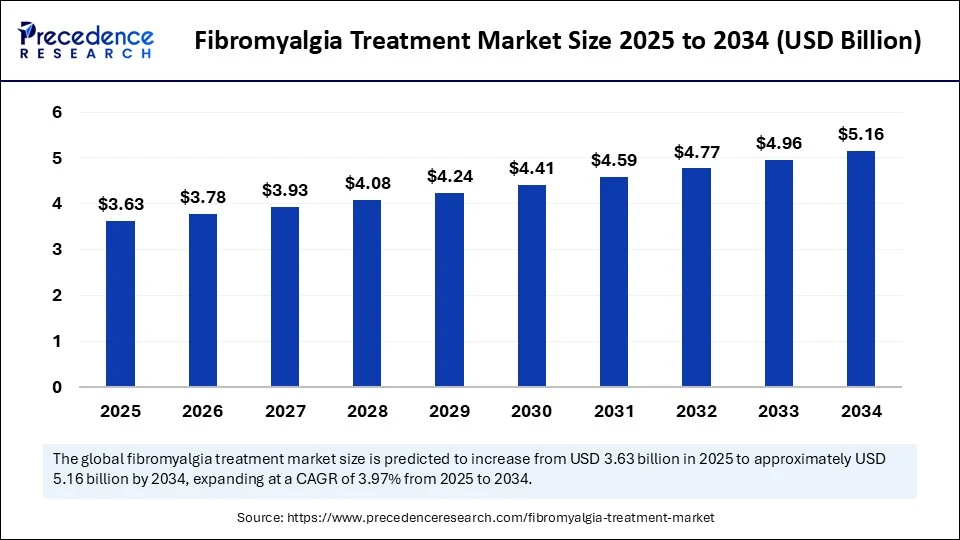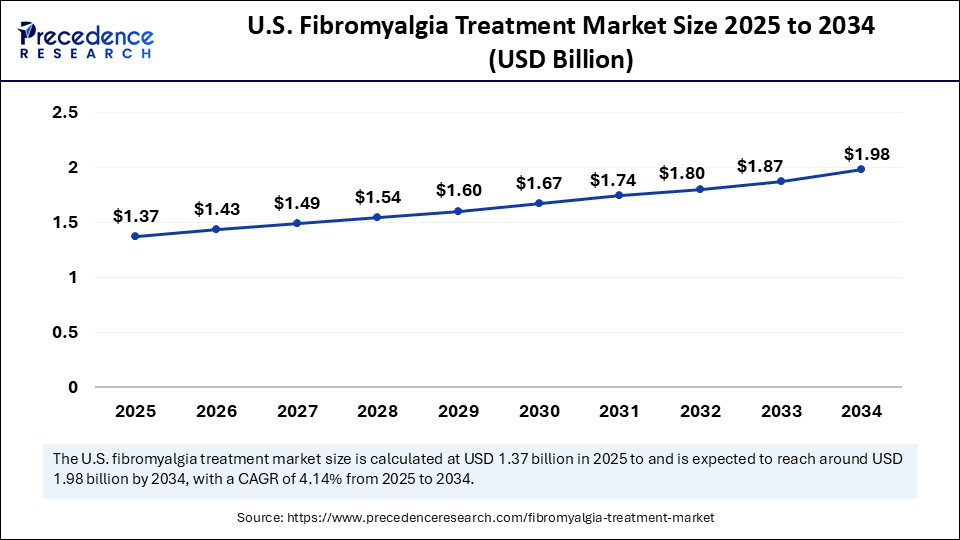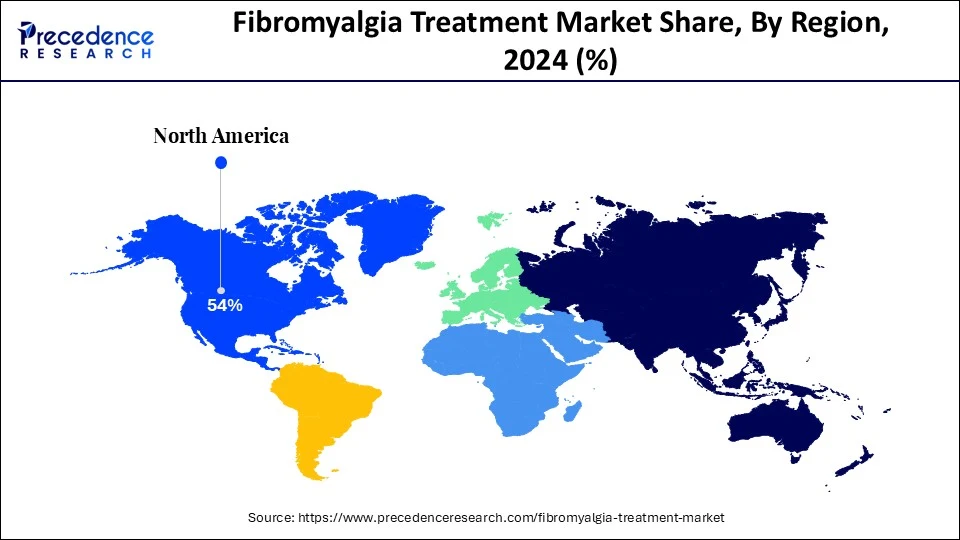List of Contents
What is the Fibromyalgia Treatment Market Size?
The global fibromyalgia treatment market size is calculated at USD 3.63 billion in 2025 and is predicted to increase from USD 3.78 billion in 2026 to approximately USD 5.16 billion by 2034, expanding at a CAGR of 3.97% from 2025 to 2034.The growing adoption of combination therapies, biologics, and personalized medicine approaches enhances treatment outcomes, driving the market's growth in emerging nations. The three drugs that are FDA-approved specifically for fibromyalgia include pregabalin (Lyrica), duloxetine (Cymbalta), and milnacipran (Savella).??Additionally, North America dominated the market, fuelled by the high healthcare expenditure and accessibility of advanced treatments.

Fibromyalgia Treatment Market Key Takeaways
- North America dominated the fibromyalgia treatment market with the largest market share of 54% in 2024.
- Asia Pacific is expected to be the fastest-growing region in the upcoming years.
- By treatment type, the pharmacologic segment captured the biggest market share of 55% in 2024.
- By treatment type, the digital therapeutic segment is expected to grow with the highest CAGR in the market during the studied years.
- By pharmacologic class, the anticonvulsants / α2δ ligands segment led the market in 2024.
- By pharmacologic class, the analgesics / NSAIDs segment is expected to show the fastest growth over the forecast period.
Fibromyalgia Treatment: What's Next for This Complex Market?
The fibromyalgia treatment market covers pharmacologic and non-pharmacologic therapies used to manage fibromyalgia (a chronic centralized pain syndrome characterized by widespread pain, fatigue, sleep disturbance, and cognitive symptoms). The market includes approved drugs, off-label medications, non-drug therapies (exercise, CBT, physical therapy), neuromodulation and device-based pain management, digital therapeutics/telehealth programs, combination care pathways, and related services (diagnosis, long-term management, and specialty pain clinic services).?This condition can affect individuals of all ages, including children, adolescents, and the elderly.
How Has AI Integration in the Fibromyalgia Treatment Market Impacted It?
As AI technology continues to advance, the integration of artificial intelligence (AI) is significantly transforming the growth of the fibromyalgia treatment market by accelerating the process of drug discovery, the potential to revolutionize diagnosis, and optimizing clinical trials. AI algorithms assist in identifying potential drug candidates by effectively analyzing large datasets and predicting their efficacy. Several researchers and healthcare specialists are increasingly exploring the potential of AI to identify objective biomarkers, improve diagnostic accuracy, and obtain deeper knowledge into the underlying mechanisms of fibromyalgia. AI-powered solutions enhance diagnostic accuracy, personalize treatment plans, and improve overall treatment outcomes. AI can also effectively analyze numerous data such as patient medical history, genetics, and lifestyle, to recommend personalized treatment strategies which often include exercise, medication, and pain management techniques.?
Market Outlook
- Industry Growth Overview
The fibromyalgia treatment market is growing, driven increasing prevalence of the health condition and a deeper understanding of its significant mechanisms. Advancement of novel drugs, the growing application of combined treatments such as medications, lifestyle changes, and non-pharmacological therapies, and an increasing in post-COVID-19 fibromyalgia cases. - Global Expansion
The fibromyalgia treatment market is experiencing global expansion, as growing awareness, rising diagnoses, and the development of novel pharmaceutical and non-pharmaceutical therapies. North America is dominated in the market due to the increasing prevalence of the condition, robust research and development spending from pharmaceutical companies. - Major investors
The major players and investors in the fibromyalgia treatment market are primarily large pharmaceutical and biopharmaceutical companies, with Pfizer Inc., Eli Lilly and Company, and AbbVie Inc., which developed and market a number of FDA-approved drugs.
What Are the Key Trends in the Fibromyalgia Treatment Market?
- The rising development of innovative treatment options for fibromyalgia is expected to drive the market's growth during the forecast period.
- The surging healthcare expenditure and insurance coverage for chronic pain management are anticipated to promote the growth of the fibromyalgia treatment market.
- The surge in the female population will significantly fuel the expansion of the fibromyalgia treatment market in the coming years. A substantial majority of fibromyalgia patients are women, which increases the need for effective treatments tailored to the individual patient's demographic.
- The rising advancement in medical research focused on effective treatment options is expected to accelerate the market's revenue during the forecast period.
- The increasing introduction of new drug classes, which may offer high efficacy and tolerability, is propelling the growth of the market during the forecast period.
Market Scope
| Report Coverage | Details |
| Market Size by 2034 | USD 5.16 Billion |
| Market Size in 2026 | USD 3.78 Billion |
| Market Size in 2025 | USD 3.63 Billion |
| Market Growth Rate from 2025 to 2034 | CAGR of 3.97% |
| Dominating Region | North America |
| Fastest Growing Region | Asia Pacific |
| Base Year | 2024 |
| Forecast Period | 2025 to 2034 |
| Segments Covered | Treatment Type, Pharmacologic Class, and Region |
| Regions Covered | North America, Europe, Asia-Pacific, Latin America, and Middle East & Africa |
Market Dynamics
Drivers
Growing Demand for Fibromyalgia Treatment
The surge in the number of fibromyalgia cases, particularly among women, is expected to boost the growth of the fibromyalgia treatment market during the forecast period. Fibromyalgia is a disorder which is characterized by widespread pain and tenderness, fatigue, sleep disturbances, cognitive issues, and mood swings, impacting millions of people globally. The surge in the number of fibromyalgia cases around the world has led to an increasing need for fibromyalgia treatment. This health condition is often undiagnosed or misdiagnosed, but awareness among health care professionals and patients, particularly in countries with adequate infrastructure, supports the growth of diagnostic and treatment infrastructure. Fibromyalgia is highly prevalent, especially among women, which directly increased the demand for effective treatments tailored to their demographic. Between the ages of 30 and 50 years, women are most likely to experience more fibromyalgia symptoms as compared to men. Women have a seven to nine times higher incidence rate than men.
According to the article published in December 2024, fibromyalgia (FM) affects around 2%–8% of the global population. Sometimes, diagnosing this condition is challenging as different countries use varying standards to diagnose it. Additionally, almost 84% of FM patients have comorbid disorders, with 67% having other musculoskeletal conditions, 35% having psychological disorders, 27% having gastrointestinal disorders, 23.5% having cardiovascular disorders, and 19% having endocrinological disorders.
Restraint
Prohibitive Treatment Costs
The high cost associated with the fibromyalgia treatment is anticipated to hamper the market's growth. Several effective fibromyalgia treatments, including therapies and medications, are expensive, which often results in a slow adoption rate. In addition, the lack of adequate infrastructure and limited awareness among physicians, particularly in middle and lower-income countries, potentially leads to underdiagnosis or misdiagnosis. Such factors may hinder the growth of the global fibromyalgia treatment market during the forecast period.
Opportunity
Rising Research and Development Expenditure
The increasing research and development activities are projected to offer lucrative growth opportunities to the fibromyalgia treatment market in the coming years. Several research studies are underway, intending to identify the specific mechanisms that cause fibromyalgia pain, paving the way for innovative pain management strategies. The market is experiencing research and development in fibromyalgia pain management is actively increasing,?focusing on both pharmacological and non-pharmacological approaches.?This also often includes developing new medications, exploring novel therapies, and significantly improving diagnostic tools. Additionally, efforts are increasingly being made by prominent market players to develop new classes of analgesics for fibromyalgia.
Sehmental Insights
Treatment Type Inisghts
Which Treatment Type Led the Fibromyalgia Treatment Market in 2024?
In 2024, the pharmacologic segment registered its dominance. The increasing demand for pharmacological treatment to manage the condition drives the growth of the segment. Medications such as milnacipran, duloxetine, and pregabalin are widely used as first-line treatments owing to their effectiveness in addressing pain and alleviating other fibromyalgia symptoms. Several pharmaceutical companies are actively participating in developing new and innovative treatments for fibromyalgia, with numerous drugs in the pipeline. On the other hand, the digital therapeutic segment is expected to witness the fastest growth in the market over the forecast period, owing to the?increasing awareness of chronic management treatment, rapid technological advancements in treatment options, and a surge in the number of diagnosed cases. Digital therapeutics is emerging as an innovative approach in the market.?Digital therapeutic solutions, such as apps and wearable devices, are gaining immense popularity for effectively managing symptoms, improving patient engagement, providing personalized treatment plans, and enhancing remote monitoring accessibility.
Pharmacologic Class Insights
What Causes the Anticonvulsants / α2δ Ligands Segment to Dominate the Fibromyalgia Treatment Market in 2024?
The anticonvulsants / α2δ ligands were dominant, with the biggest share of the global fibromyalgia treatment market in 2024, owing to the rising incidence of fibromyalgia and the increasing effectiveness of these medications in managing chronic pain.?Gabapentin and pregabalin, which act as α2δ ligands, are first-line treatments for fibromyalgia pain. These medications generally provide pain relief for fibromyalgia treatment, making them a popular treatment option among patients. On the other hand, the analgesics / Nonsteroidal anti-inflammatory drugs (NSAIDs) segment is expected to register the fastest growth. The segment's growth is supported by the rising awareness of pain management options and the growing pipeline of new fibromyalgia treatments. These medications help to reduce symptoms in patients with fibromyalgia.
Regional Analysis
U.S. Fibromyalgia Treatment Market Size and Growth 2025 to 2034
The U.S. fibromyalgia treatment market size is exhibited at USD 1.37 billion in 2025 and is projected to be worth around USD 1.98 billion by 2034, growing at a CAGR of 4.14% from 2025 to 2034.

What Made North America Dominate the Fibromyalgia Treatment Market in 2024?
In 2024, North America captured a major revenue share in the fibromyalgia treatment market. This North American region holds a strong position in the fibromyalgia treatment market, high prevalence of fibromyalgia, presence of a thriving pharmaceutical sector, a surge in healthcare spending, and an increasing FDA-approved drugs. The region is a major contributor to the market, owing to the improved diagnostic capabilities, prevalence of fibromyalgia, and the increasing availability of advanced treatment options. Patients are increasingly seeking treatment, owing to the rising awareness programs and insurance coverage. The region is also supported by regulatory agencies' evolving policies that streamline approval processes for innovative treatments. The rising focus on developing personalized medicine, digital health technologies, and telemedicine solutions is transforming treatment paradigms, enhancing market reach, and improving patient treatment outcomes in the region. Pharmaceutical companies are heavily investing in research to find advanced drugs and therapies for numerous fibromyalgia symptoms, such as sleep disturbances, pain, musculoskeletal pain, fatigue, mood disorders, and others.
The U.S. Fibromyalgia Treatment Market Trends
The U.S. country has a well-established healthcare infrastructure, a robust presence of key pharmaceutical companies, high per capita healthcare expenditure, a surge in the women's population, and increasing availability of effective drugs & therapies. This increasing prevalence of fibromyalgia has led to and growing demand for effective treatment options in the country. The U.S. Food and Drug Administration has approved drugs like milnacipran, duloxetine, and pregabalin as the first medications used due to for fibromyalgia treatment, demonstrating effectiveness in reducing pain and improving function.? In addition, pharmacologic therapies, non-pharmacologic therapies, neuromodulation therapies, and digital therapeutics are increasingly becoming popular in the country, offering innovative solutions for managing chronic symptoms, improving patient engagement, and providing personalized treatment plans. Pharmaceutical companies are actively involved in research & development activities to develop novel drugs and therapies, such as targeting specific symptoms and underlying mechanisms of the condition.

Which Factors Are Going to Play a Crucial Role in the Asia Pacific Expansion?
During 2025-2034 in the fibromyalgia treatment market, the Asia Pacific market is expanding steadily, attributed to the high incidences of fibromyalgia, extensive pharmaceutical industry, favorable reimbursement policies, expanding regulatory approval, growing demand for chronic pain management, and rapid advancement in medical research focused on effective treatment options. The surge in the women population, expanding geriatric population, and lifestyle changes factors such as stress and sedentary habits, contribute to the market's growth during the forecast period. The region has a rapidly developing healthcare infrastructure, surging investment in the development of availability of advanced therapies, and the availability of specialized clinics. Emerging trends include the availability of pharmacological and non-pharmacological treatments, increasing use of? telemedicine for diagnosis, and the growing shift toward precision medicine, bolstering the region's expansion. Governments are increasingly prioritizing the pharmaceutical sector and supporting the development of new drugs and advanced therapies.?The rising fibromyalgia diagnosis rates, along with the wide availability of advanced treatment, are expected to boost the market's revenue during the forecast period.
India: Large-scale Generic Drug Production
India is a worldwide leader in generic healthcare manufacturing. The loss of patent protection for key fibromyalgia drugs such as Lyrica (pregabalin) has enabled Indian manufacturers like Lupin Limited, Sun Pharmaceutical Industries Ltd., Zydus Lifesciences Ltd. The country is observing an enhancement in healthcare infrastructure, with an evolving in specialized pain management surgeries and hospitals.
Europe: Rising awareness and diagnosis
Europe is significantly growing the market due to rising awareness, a growing prevalence of the chronic condition, and a stronger medical care infrastructure. Supportive regulatory initiatives, growing healthcare spending, and extensive research and development by healthcare organizations contribute to this growth. Pharmaceutical organizations are investing in research to develop novel and improved treatments, and there is an increasing focus on chronic pain management, which contributes to the growth of the market.
UK: Increasing Aging Population
In the UK, increasing emphasis is placed on inclusive treatment plans that incorporate different strategies, including medications such as anticonvulsants, antidepressants, physical therapy, and psychological interventions like cognitive-behavioral therapy (CBT). The shift toward targeted medicine, tailoring treatments to specific patient requirements, is also increasing demand for a broader variety of options.
Fibromyalgia Treatment Market- Value Chain Analysis
- R&D:
The R&D process for fibromyalgia treatments usually follows the standard drug advancement pipeline, which includes basic research and preclinical testing- Key Players: Pfizer Inc. and AbbVie Inc.
- Key Players: Pfizer Inc. and AbbVie Inc.
- Clinical Trials:
It includes preclinical research and clinical trial phases such as phase I, phase II, phase III, and phase IV- Key Players: Eli Lilly and Company
- Key Players: Eli Lilly and Company
- Patient Services:
Fibromyalgia treatment contains patient-centered, multidisciplinary strategies focused on managing symptoms and enhancing daily function, rather than seeking a cure.- Key Players: GlaxoSmithKline (GSK) plc and Teva Pharmaceutical Industries Ltd.
Top Vendors in the Fibromyalgia Treatment Market & Their Offerings

|
Company |
Headquarters |
Key Strengths |
Latest Info (2025) |
|
Pfizer |
United States |
Robust R&D capabilities |
Pfizer continues to pursue an indication for Lyrica CV in the treatment of GAD, a chronic disorder characterized by persistent anxiety, exaggerated worry, and tension that results in impairment of daily function. |
|
Eli Lilly |
Indianapolis, Indiana, USA |
Robust and innovative product portfolio |
Eli Lilly has recently shifted its pain pipeline priorities, including sidelining some mid-stage pain candidates. |
|
Teva Pharmaceutical Industries |
Tel Aviv, Israel |
Leadership in generic medicines |
Teva also has a generic form of cyclobenzaprine (Amrix), a muscle relaxant sometimes used off-label for symptom relief. |
|
Allergan / AbbVie |
North Chicago, Illinois |
Robust R&D innovations |
In October 2025, AbbVie announced positive topline results from the Phase 2 ELATE trial evaluating the safety and efficacy of onabotulinumtoxinA (BOTOX) compared to placebo for the treatment of upper limb essential tremor. |
|
Novartis |
Basel, Switzerland |
Strong financial performance |
Novartis Cosentyx meets primary and all secondary endpoints in Phase III trial in patients with polymyalgia rheumatica (PMR) |
Other Major Companies
- Sun Pharmaceutical Industries
- Astellas Pharma
- Tonix Pharmaceuticals
- Aptinyx
- Axsome Therapeutics
- Scilex
- Johnson & Johnson
- Medtronic
- Boston Scientific
- Nevro Corp.
- Abbott
Latest Announcements by Industry Leaders
- In July 2024, the FDA granted fast-track designation to a sublingual tablet form of the muscle relaxant cyclobenzaprine hydrochloride for the management of fibromyalgia. Tonix Pharmaceuticals reported that its patented form of the drug, Tonmya, received the designation following the results of the phase 3 RESILIENT study. In that study, Tonmya significantly reduced daily pain compared with placebo in patients with fibromyalgia.
(Source: https://www.healio.com)
Recent Developments
- In October 2024, Lin Health, a digital platform helping people reclaim their lives from chronic pain, announced a collaboration with Mayo Clinic to improve care transition support for patients who complete the Fibromyalgia Treatment Program on Mayo Clinic's campus in Rochester, Minnesota. Following the initial few months of results, the collaboration is slated to expand to support Mayo Clinic primary care patients in Arizona, providing an at-home, high-touch digital intervention that offers patients longitudinal, real-time support for chronic pain.
(Source: https://www.prnewswire.com) - In January 2025, Silo Pharma, Inc., a developmental-stage biopharmaceutical company focused on developing novel formulations and drug delivery systems for traditional therapeutics and psychedelic treatments, announced that the U.S. Patent and Trademark Office (USPTO) issued a notice of allowance for patent application 17/954,864 for pharmacological prophylactics against stress-induced affective disorders in females.
(Source: https://firstwordpharma.com)
Segments Covered in the Report
By Treatment Type
- Pharmacologic Therapies
- Non-Pharmacologic Therapies
- Device & Neuromodulation Therapies
- Digital Therapeutics
- Combination / Multimodal Care Pathways
By Pharmacologic Class
- Anticonvulsants / Α2δ Ligands
- SNRIs
- Tricyclic Antidepressants
- Opioids & Weak Opioids
- Analgesics / NSAIDs
- NMDA Modulators, Serotonergic Modulators, Novel Small Molecules
- Cannabinoids & Complementary Botanicals
By Region
- North America
- Europe
- Asia Pacific
- Latin America
- Middle East and Africa
For inquiries regarding discounts, bulk purchases, or customization requests, please contact us at sales@precedenceresearch.com
Frequently Asked Questions
Ask For Sample
No cookie-cutter, only authentic analysis – take the 1st step to become a Precedence Research client



